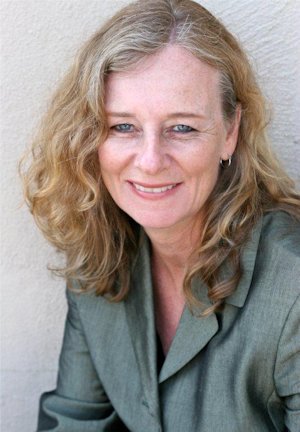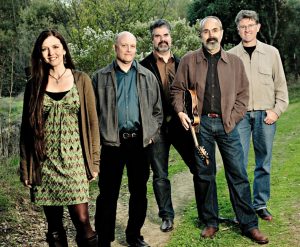John Reischman & the Jaybirds for one impeccable night
Seamless technique and golden tone are the hallmarks of mandolinist John Reischman, who returned to San Diego Saturday night, along with his captivating band The Jaybirds.
As the crow flies, it’s about 1,132 miles from San Diego to British Columbia, where Reischman and most of the band are based. That sort of explains why they haven’t played here since 2006. But given the exquisite yet understated performance, their many fine recordings, and the wildly growing popularity of bluegrass and similar strains, I cannot understand why they did not fill the little church venue in Normal Heights.
Along with mandolinist and singer Reischman, whose style is influenced by jazz and Latin music, Doc Watson, Norman Blake, Sam Bush and David Grisman, the band includes: fiddle player Greg Spatz, who is also an author; banjo player and singer Nick Hornbuckle, who plays with just two fingers; upright bass player and singer Trisha Gagnon, who sells homemade jam during intermission; and guitar player and singer Jim Nunally. He’s won a few Grammys.
The program had deep roots interspersed with original works. Many were from the CD Vintage and Unique. They opened with Reischman’s version of “Shady Grove,” a cherished American tune.
“Peaches in the summertime,
Apples in the fall,
If I can’t get the girl I love,
Won’t have none at all…”
I’ve heard dozens of renditions – by Doc Watson, David Grisman, and Jerry Garcia to name a few – but sitting on a cushioned pew in church, I was struck by this band’s ability to make the classic sound new.
Nunally was able to shoot his voice up high and be the anchor in old-school bluegrass, and also be very snappy in guitar leads. He broke a string and didn’t have a spare guitar. Instead, he stepped off to the side and restrung his precious old Martin.
There was no grandstanding, no showboating here. They took their time introducing each song and stepped up to the single microphone with precision. It was all about taking turns and humility. Gagnon’s pleasant voice balanced out Nunally’s nasality, and watching her graceful dance with a full size bass was almost as engaging as her singing.
Gagnon was spot on in the lead of “Gabriel’s Call,” a thrilling gospel quartet that rocked our cores and rattled the old beams overhead. Her song “Parent’s Prayer,” a tribute to the birth of her sister’s children, was memorable too. A celebration of new life, it could be the standard at baptisms and birthdays.
Hornbuckle, who is also a bass player, was especially creative with the banjo, able to glean delicate tones by tapping the neck. In “Black Road,” his banjo was a big river of sound, with others joining in like inlets, all taking turns. He was also a smart comedian in between songs.
Spatz grabbed my attention in “Fiddler’s Dream” which he played with wonderful expression. He held his instrument tightly under his chin, then carved into the strings while maintaining tune.
Reischman’s mandolin playing has been compared to maple syrup, in a smooth way. While some may say he’s too smooth, he was never too slippery in this concert, and he dug in. He chopped hard when he needed to, as in “Bash Bish Falls.” And the fast tremolos, well, they trembled rapidly while he held his mandolin almost parallel to the ground.
A lot has been written about his main mandolin, a 1924 Gibson F5, signed by the esteemed Lloyd Loar. It’s the same type as Bill Monroe’s. Monroe bought his in 1945 for $150. (An angry girlfriend smashed it, he had it rebuilt, and it now rests in a museum). Reischman took out a loan and traded in several fine instruments to get his many years ago. His Loar F5 has the most wonderful tone and is probably worth about $250,000. Think of it as the third cousin of a Stradivari. Google Antiques Roadshow to hear more tales of discovered gems.
Still, during the concert, I was more curious about his picking style.
In every tune, Reischman’s mandolin was articulated. He held his pick tightly with his wrist high. During an introduction, he dryly explained that his picks are made of cheese. Not really. He has his own model, a Red Bear. It’s medium thickness, similar to tortoise shell. The trick according to Reischman, is never flex. His signature instrumental “Salt Spring” was saved for last and never flexed. The audience couldn’t help but stomp feet and go along for the joyful ride.
Reischman and the Jaybirds are a first-rate group. The superb musicianship was balanced by a humorous sideshow and storytelling, with only one flaw. They could have sounded even better. All of their instruments were wireless, and they used one center vocal mic. That made the concert visually engaging and dynamic for the ears, but there was too much treble. The sweet sound became muddy and echoed. The next time Reischman and the Jaybirds fly south, San Diego should give them more recognition and a cleaner sound system.

Kris Eitland covers dance and theater for Sandiegostory.com and freelances for other publications, including the Union Tribune and Dance Teacher Magazine. She grew up performing many dance styles and continued intensive modern dance and choreography at the Univ. of Minnesota, Duluth, and San Diego State Univ. She also holds a journalism degree from SDSU. Her career includes stints in commercial and public radio news production.
Eitland has won numerous Excellence in Journalism awards for criticism and reporting from the San Diego Press Club. She has served on the Press Club board since 2011 and is a past president. She is a co-founder of Sandiegostory.com. She has a passion for the arts, throwing parties with dancing and singing, and cruising the Pacific in her family’s vintage trawler. She trains dogs, skis, and loves seasonal trips to her home state of Minnesota.



